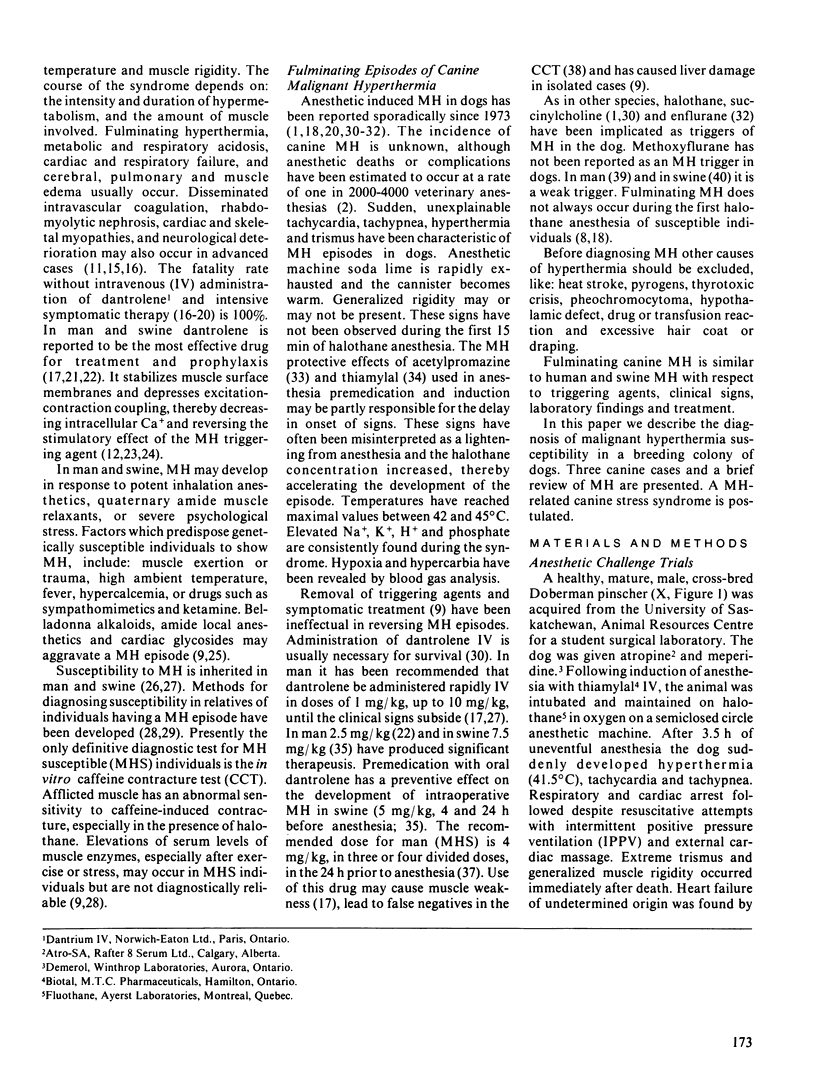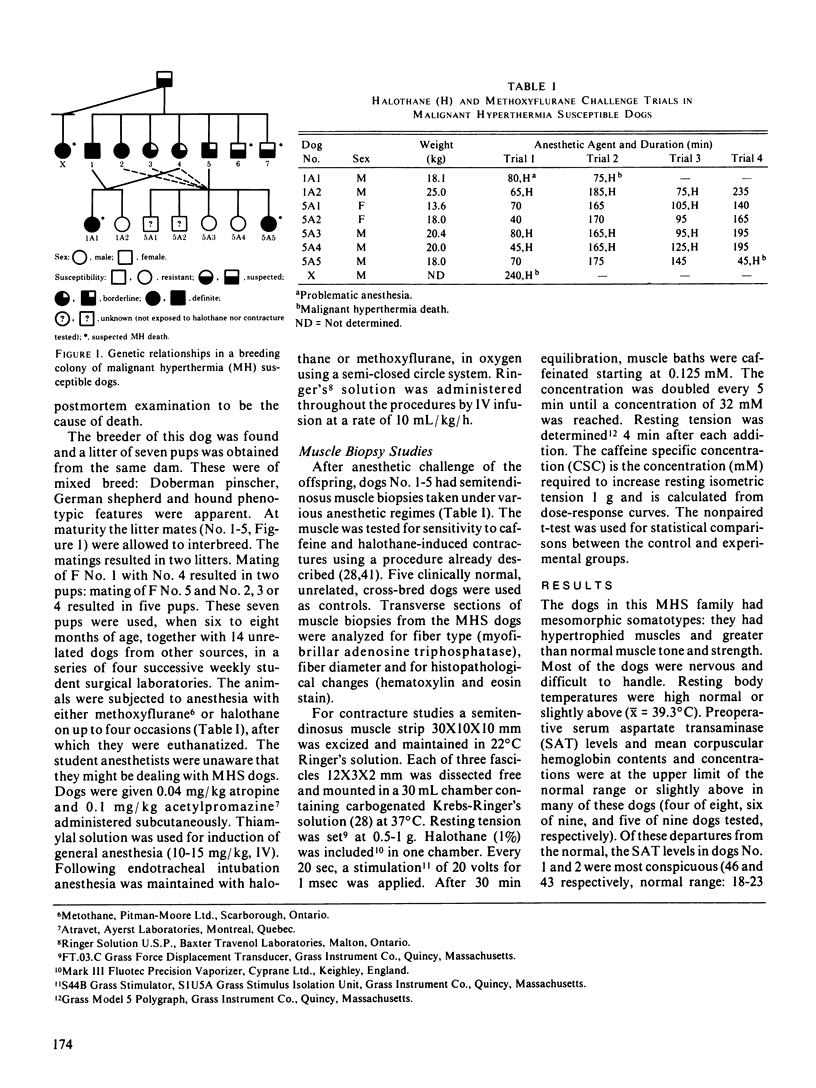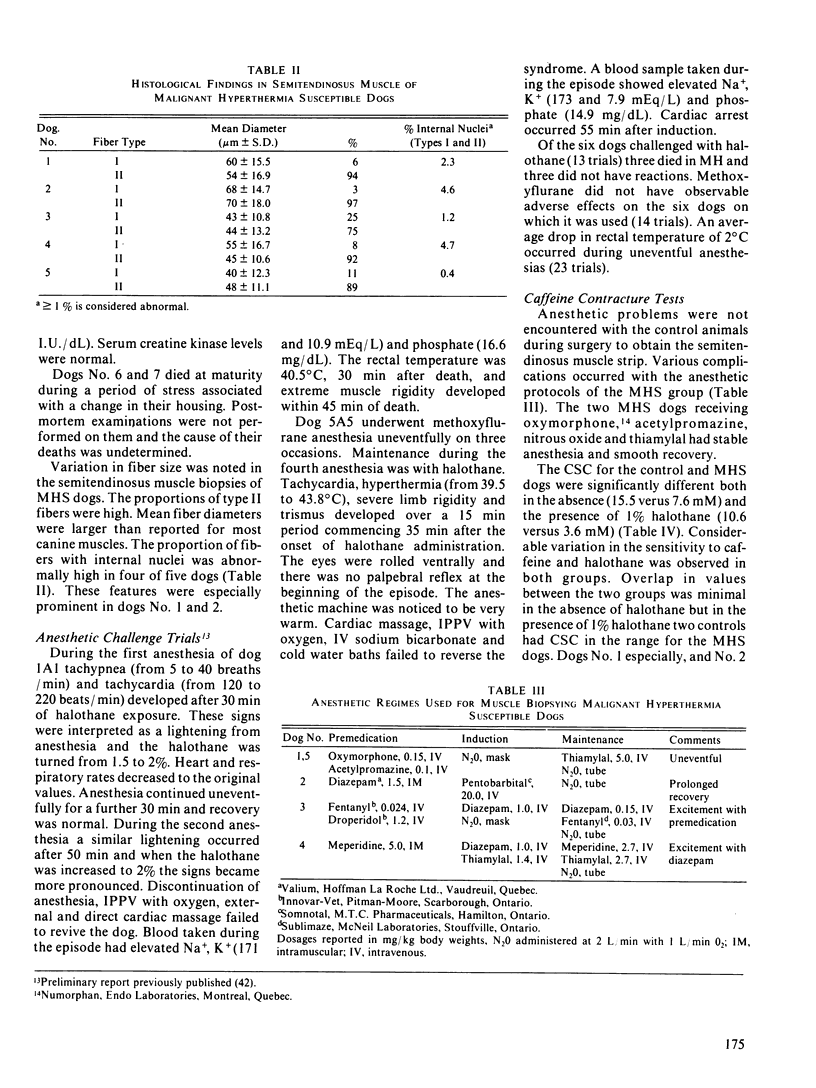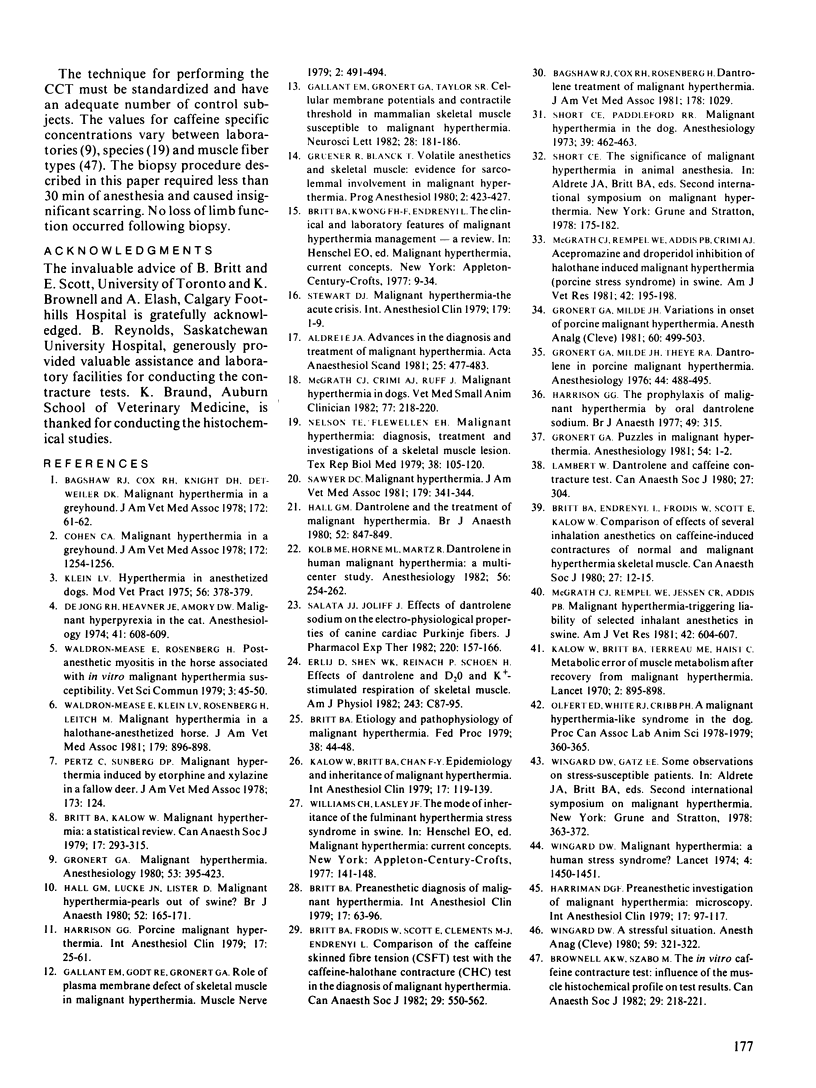Abstract
Fifteen related dogs were studied for susceptibility to malignant hyperthermia using halothane challenge and caffeine contracture tests. These dogs had hypertrophied muscles, were of a nervous temperament and had rectal temperatures at the upper limit of the normal range. Clinical pathology findings were mild elevations of serum aspartate transaminase and mean corpuscular hemoglobin. In vitro caffeine contracture tests were performed on muscle biopsies from five of these dogs. The concentration of caffeine required to increase resting tension by 1 g in biopsy specimens of these dogs was significantly lower than that required for control dogs: 7.6 ± 1.38 (x̄ ± SEM) versus 15.5 ± 2.52 mM (P < 0.025), and in the presence of 1% halothane, 3.6 ± 1.44 versus 10.6 ± 2.19 mM (P < 0.05). Internal nuclei, fiber caliber variation and fiber hypertrophy were found in histological studies of muscle biopsies. Two other dogs possibly died of a canine stress syndrome analagous to the porcine stress syndrome which occurs in malignant hyperthermia susceptible swine. Eight others of this family were anesthetized with halothane or methoxyflurane. Methoxyflurane did not trigger the syndrome. The first exposure to halothane caused death from malignant hyperthermia in two dogs and a third died on the second exposure to halothane. Postmortem findings were nonspecific. The other three dogs exposed to halothane recovered uneventfully. Inheritance of the defect conforms to a multifactorial pattern, with gradations of susceptibility.
Full text
PDF





Selected References
These references are in PubMed. This may not be the complete list of references from this article.
- Aldrete J. A. Advances in the diagnosis and treatment of malignant hyperthermia. Acta Anaesthesiol Scand. 1981 Dec;25(6):477–483. doi: 10.1111/j.1399-6576.1981.tb01690.x. [DOI] [PubMed] [Google Scholar]
- Bagshaw R. J., Cox R. H., Knight D. H., Detweiler D. K. Malignant hyperthermia in a Greyhound. J Am Vet Med Assoc. 1978 Jan 1;172(1):61–62. [PubMed] [Google Scholar]
- Britt B. A., Endrenyi L., Frodis W., Scott E., Kalow W. Comparison of effects of several inhalation anaesthetics on caffeine-induced contractures of normal and malignant hyperthermic skeletal muscle. Can Anaesth Soc J. 1980 Jan;27(1):12–15. doi: 10.1007/BF03006841. [DOI] [PubMed] [Google Scholar]
- Britt B. A. Etiology and pathophysiology of malignant hyperthermia. Fed Proc. 1979 Jan;38(1):44–48. [PubMed] [Google Scholar]
- Britt B. A., Frodis W., Scott E., Clements M. J., Endrenyi L. Comparison of the caffeine skinned fibre tension (CSFT) test with the caffeine-halothane contracture (CHC) test in the diagnosis of malignant hyperthermia. Can Anaesth Soc J. 1982 Nov;29(6):550–562. doi: 10.1007/BF03007740. [DOI] [PubMed] [Google Scholar]
- Britt B. A., Kalow W. Malignant hyperthermia: a statistical review. Can Anaesth Soc J. 1970 Jul;17(4):293–315. doi: 10.1007/BF03004694. [DOI] [PubMed] [Google Scholar]
- Britt B. A. Preanesthetic diagnosis of malignant hyperthermia. Int Anesthesiol Clin. 1979 Winter;17(4):63–96. doi: 10.1097/00004311-197917040-00006. [DOI] [PubMed] [Google Scholar]
- Brownell A. K., Szabo M. The in-vitro caffeine contracture test: influence of the muscle histochemical profile on test results. Can Anaesth Soc J. 1982 May;29(3):218–221. doi: 10.1007/BF03007119. [DOI] [PubMed] [Google Scholar]
- Cohen C. A. Malignant hyperthermia in a greyhound. J Am Vet Med Assoc. 1978 Jun 1;172(11):1254–1256. [PubMed] [Google Scholar]
- Erlij D., Shen W. K., Reinach P., Schoen H. Effects of dantrolene and D2O on K+-stimulated respiration of skeletal muscle. Am J Physiol. 1982 Jul;243(1):C87–C95. doi: 10.1152/ajpcell.1982.243.1.C87. [DOI] [PubMed] [Google Scholar]
- Gallant E. M., Godt R. E., Gronert G. A. Role of plasma membrane defect of skeletal muscle in malignant hyperthermia. Muscle Nerve. 1979 Nov-Dec;2(6):491–494. doi: 10.1002/mus.880020610. [DOI] [PubMed] [Google Scholar]
- Gallant E. M., Gronert G. A., Taylor S. R. Cellular membrane potentials and contractile threshold in mammalian skeletal muscle susceptible to malignant hyperthermia. Neurosci Lett. 1982 Feb 12;28(2):181–186. doi: 10.1016/0304-3940(82)90149-5. [DOI] [PubMed] [Google Scholar]
- Glickman L. T., Appel M. J. Parvovirus infection and distemper vaccination. J Am Vet Med Assoc. 1981 May 15;178(10):1029–1031. [PubMed] [Google Scholar]
- Gronert G. A. Malignant hyperthermia. Anesthesiology. 1980 Nov;53(5):395–423. doi: 10.1097/00000542-198011000-00007. [DOI] [PubMed] [Google Scholar]
- Gronert G. A., Milde J. H., Theye R. A. Dantrolene in porcine malignant hyperthermia. Anesthesiology. 1976 Jun;44(6):488–495. doi: 10.1097/00000542-197606000-00005. [DOI] [PubMed] [Google Scholar]
- Gronert G. A., Milde J. H. Variations in onset of porcine malignant hyperthermia. Anesth Analg. 1981 Jul;60(7):499–503. [PubMed] [Google Scholar]
- Gronert G. A. Puzzles in malignant hyperthermia. Anesthesiology. 1981 Jan;54(1):1–2. [PubMed] [Google Scholar]
- Hall G. M. Dantrolene and the treatment of malignant hyperthermia. Br J Anaesth. 1980 Sep;52(9):847–849. doi: 10.1093/bja/52.9.847. [DOI] [PubMed] [Google Scholar]
- Hall G. M., Lucke J. N., Lister D. Malignant hyperthermia--pearls out of swine? Br J Anaesth. 1980 Feb;52(2):165–171. doi: 10.1093/bja/52.2.165. [DOI] [PubMed] [Google Scholar]
- Harriman D. G. Preanesthetic investigation of malignant hyperthermia: microscopy. Int Anesthesiol Clin. 1979 Winter;17(4):97–117. doi: 10.1097/00004311-197917040-00007. [DOI] [PubMed] [Google Scholar]
- Harrison G. G. Porcine malignant hyperthermia. Int Anesthesiol Clin. 1979 Winter;17(4):25–61. doi: 10.1097/00004311-197917040-00005. [DOI] [PubMed] [Google Scholar]
- Harrison G. G. The prophylaxis of malignant hyperthermia by oral dantrolene sodium in swine. Br J Anaesth. 1977 Apr;49(4):315–317. doi: 10.1093/bja/49.4.315. [DOI] [PubMed] [Google Scholar]
- Kalow W., Britt B. A., Chan F. Y. Epidemiology and inheritance of malignant hyperthermia. Int Anesthesiol Clin. 1979 Winter;17(4):119–139. doi: 10.1097/00004311-197917040-00008. [DOI] [PubMed] [Google Scholar]
- Kalow W., Britt B. A., Terreau M. E., Haist C. Metabolic error of muscle metabolism after recovery from malignant hyperthermia. Lancet. 1970 Oct 31;2(7679):895–898. doi: 10.1016/s0140-6736(70)92069-6. [DOI] [PubMed] [Google Scholar]
- Kolb M. E., Horne M. L., Martz R. Dantrolene in human malignant hyperthermia. Anesthesiology. 1982 Apr;56(4):254–262. doi: 10.1097/00000542-198204000-00005. [DOI] [PubMed] [Google Scholar]
- Lambert W. Dantrolene and caffeine contracture test. Can Anaesth Soc J. 1980 May;27(3):304–305. [PubMed] [Google Scholar]
- McGrath C. J., Rempel W. E., Addis P. B., Crimi A. J. Acepromazine and droperidol inhibition of halothane-induced malignant hyperthermia (porcine stress syndrome) in swine. Am J Vet Res. 1981 Feb;42(2):195–198. [PubMed] [Google Scholar]
- McGrath C. J., Rempel W. E., Jessen C. R., Addis P. B., Crimi A. J. Malignant hyperthermia-triggering liability of selected inhalant anesthetics in swine. Am J Vet Res. 1981 Apr;42(4):604–607. [PubMed] [Google Scholar]
- Nelson T. E., Flewellen E. H. Malignant hyperthermia: diagnosis, treatment and investigations of a skeletal muscle lesion. Tex Rep Biol Med. 1979;38:105–120. [PubMed] [Google Scholar]
- Salata J. J., Jalife J. Effects of dantrolene sodium on the electrophysiological properties of canine cardiac Purkinje fibers. J Pharmacol Exp Ther. 1982 Jan;220(1):157–166. [PubMed] [Google Scholar]
- Sawyer D. C. Malignant hyperthermia. J Am Vet Med Assoc. 1981 Aug 15;179(4):341–344. [PubMed] [Google Scholar]
- Short C. E., Paddleford R. R. Letter: Malignant hyperthermia in the dog. Anesthesiology. 1973 Oct;39(4):462–463. doi: 10.1097/00000542-197310000-00033. [DOI] [PubMed] [Google Scholar]
- Waldron-Mease E., Klein L. V., Rosenberg H., Leitch M. Malignant hyperthermia in a halothane-anesthetized horse. J Am Vet Med Assoc. 1981 Nov 1;179(9):896–898. [PubMed] [Google Scholar]
- Wingard D. W. A stressful situation. Anesth Analg. 1980 May;59(5):321–322. [PubMed] [Google Scholar]
- Wingard D. W. Letter: Malignant hyperthermia: a human stress syndrome? Lancet. 1974 Dec 14;2(7894):1450–1451. doi: 10.1016/s0140-6736(74)90105-6. [DOI] [PubMed] [Google Scholar]
- de Jong R. H., Heavner J. E., Amory D. W. Malignant hyperpyrexia in the cat. Anesthesiology. 1974 Dec;41(6):608–609. doi: 10.1097/00000542-197412000-00014. [DOI] [PubMed] [Google Scholar]


